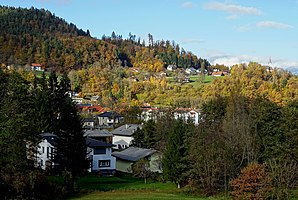St. Anna (municipality of Maria Wörth)
|
St. Anna ( Rotte ) locality |
||
|---|---|---|
|
|
||
| Basic data | ||
| Pole. District , state | Klagenfurt-Land (KL), Carinthia | |
| Judicial district | Klagenfurt | |
| Pole. local community | Maria Wörth ( KG Reifnitz ) | |
| Coordinates | 46 ° 36 '31 " N , 14 ° 10' 24" E | |
| height | 520 m above sea level A. | |
| Residents of the village | 61 (January 1, 2020) | |
| Building status | 27 (2001) | |
| Statistical identification | ||
| Locality code | 00909 | |
| Counting district / district | Maria Wörth (20 419 000) | |
 South view of the village of St. Anna - Maria Wörth municipality - with the branch church St. Anna |
||
| Source: STAT : index of places ; BEV : GEONAM ; KAGIS | ||
St. Anna ( Slovenian : Šentana ) is a group on the southern shore of Lake Wörth in Carinthia . The place is part of the municipality of Maria Wörth west above Reifnitz and has 61 inhabitants (as of January 1, 2020).
Church of St. Anna am Zackel
The branch church of St. Anna of the parish Maria Wörth is located on a hill west of the Reifnitz Bay. The church with the nowadays common name Sankt Anna am Zackel (Čachl = cone) was first mentioned in documents in 1385 and belonged to the parish of Keutschach until 1962. Due to changes in the parish boundaries, the church was separated from the Keutschach parish and assigned to the Maria Wörth parish. At that time, the church was in dire need of renovation and was renewed true to style in the years that followed. The ogival two-part tracery windows and the buttresses indicate the late Gothic style. The single-nave pilgrimage church has a steep gable roof and the sacristy tower was covered with a pointed helmet roof. During restoration work from 1964 to 1965, a valuable mural of St. Christopher was uncovered on the north wall of the branch church.
The vault of the nave is attributed to the late Gothic architectural style and shows stonemason's marks and the year 1639. The baroque altar, with the statues of Saints Anna, Maria, Jakobus and Markus at its center, dates from the 18th century. The altar table was designed from elements of the former organ . The sacristy has a late Gothic profiled entrance. The baroque statues on consoles on the triumphal arch wall represent Saint John on the left and Saint Sebastian on the right.
literature
- DEHIO Carinthia - Topographical Monument Inventory , p. 717. Verlag Anton Schroll & Co, Vienna 2001, ISBN 3-7031-0712-X





